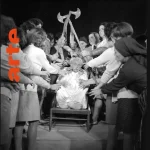| Reference Code | I/2-234 |
| Title | Writings about Skanderbeg |
| Synopsis | Researchers from different backgrounds work to better illuminate the excellent value of our people during the period of our national hero on occasion of the 500th anniversary of Gjergj Kastriot Skanderbeg. Book quote by E. Hoxha. Marlin Barleti is the first historian of our people, who described the activities of the great leader in his book “History of the life and deeds of Skanderbeg”, “Prince of Albania”. The well-known bibliographer Petrovic has written a book about Skanderbeg. The first edition of Barleti’s book was published in Rome in 1508. In 1537 in (Stramburg) and later in Frankfurt Main. It was published in Portugal in 1288 and later in Spain. In 1812 Barleti’s work was translated into Greek and Russian language. Gjon Muzaka, a fellow warrior of Skanderbeg, wrote the book on Skanderbeg’s battles against the Turks. Dhimiter Frangu, a close fighter of the hero, wrote “Commentary on the works of Gjergj Kastriot”. Frank Bardhi wrote a book about Skanderbeg. Bust of Skanderbeg. Portraits of Skanderbeg made by foreign painters. Our painters and sculptors, old and young, have presented the hero with a sword in his hand. A series of scholars such as Shafarik Muhashero, Ljubic, Tainer have published extracts of Skanderbeg’s documents and correspondence. (366.30) In 1658, in Bysnier, Kokeri published the poem “Skanderbeg” in Latin. Kaher wrote the poem “Skanderbeg “in 1643. La Rosh created the novel “The Great Skanderbeg”. Sharameli published a heroic poem about the legendary brave. A literary biography was published in Portugal by Menezes Wynkop, who wrote a tragedy for Skanderbeg. Book with signatures in 1701 Dondiu was inspired by a heroic poem about Skanderbeg. Bilcimestu wrote a literary biography about Skanderbeg in Romanian language. Poet Andrej Kocic Kujan wrote a poem in Latin langauge and a Serbian poem for our hero. The book of rhymes. The famous poet Llongjero wrote a poem with which he marked Skanderbeg’s return to his homeland. Book with pictures. The well-known Byzantine chronicler Kolko Konodili shows his admiration for the bravery of Skanderbeg and the bravery of Albanians in the area of Kruje. Historians speak with respect about Skanderbeg. Kantimiro in the “History of the Ottoman Empire”. La Martino, in the French work “The History of Turkey”. Homer, in his work “The History of the Ottoman Empire” etc. Writers such as Gjon Buzuku, Lek Matrenga, Pjeter Budi, Fran Bardhi, Pjeter Bogdani have preserved the Albanian language of Skanderbeg’s time. Sami Frasher’s literary works for Skanderbeg, Jeronin De Rada, is the first writer in Albanian artistic literature who sang for Skanderbeg. Bust of Skanderbeg. |
| Awards | |
| Screenwriter | Jakup Kosteti |
| Scriptwriter | |
| Director | Ilo Pando |
| Composer | Donika Muco |
| Camera | Sokrat Musha Koco Tollko, op zeri |
| Designer | |
| Editing | |
| Sound | |
| Category | Documentaries |
| Chroma | |
| Year | 1967 |
| Release date | 1967 |
| Reels | 2 |
| Lenght (in minutes) | 16 |
| Country of origin | Shqiperi |
| Shooting locations | |
| Producers | Kinostudio “Shqiperia e re” |
| Notes | |
| © Copyright | Arkivi Qendror Shtetëror i Filmit |
Share This Article




